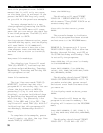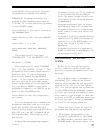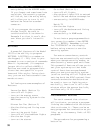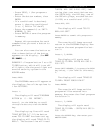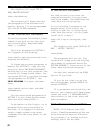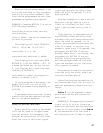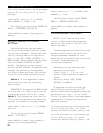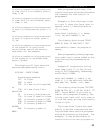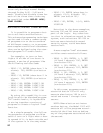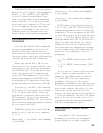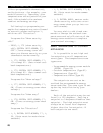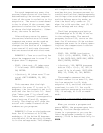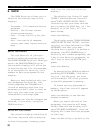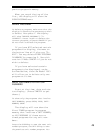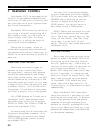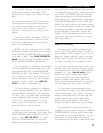
44
Home Automation, Inc.
occur only during a normal Monday
through Friday 9:00 - 5:00 work
week. Enable and disable times for
each of the three time clocks may
be specified under SET-UP MISC,
TIME CLOCKS.
BUTTONS ACTIVATING OTHER BUTTONS
It is possible to program a but-
ton to activate another button.
This advanced programming technique
can be used to have a common group
of programs run on the occurrence
of different events, or to program
more complex conditional statements
than can be defined using the stan-
dard program “if” conditionals.
For example, to turn on four
lights if either of two doors is
opened, a series of programs like
the following could be used:
- PROG * 11, ENTER (when door 1 in
alarm): 190, ENTER (run button
190)
- PROG * 13, ENTER (when door 2 in
alarm): 190, ENTER (run button
190)
- PROG * 190, ENTER: LIGHT 1 ON
- PROG * 190, ENTER: LIGHT 2 ON
- PROG * 190, ENTER: LIGHT 3 ON
- PROG * 190, ENTER: LIGHT 4 ON
By using this capability in con-
junction with the standard program
“if” conditionals, it is possible
to string together a series of
programs to create a logical “and”
function.
As a simple example, the follow-
ing sequence of programs could be
used to turn on a light when a door
is opened if it is dark outside and
if the system is in the away mode:
By using this capability in conjunction with
the standard
program “if” conditionals, it is possible to
string
together a series of programs to create a
logical “and”
function.
As a simple example, the following sequence
of programs
could be used to turn on a light when a door
is opened if
it is dark outside and if the system is in the
away mode:
RUN BUTTON 179 WHEN DOOR IN
ALARM IF DARK
LIGHT ON WHEN BUTTON 179 IF
AWAY
Note that in both of the above examples,
button 179 was
used as part of the logic. Any other button
that is
otherwise unused in the system, such as
buttons 180-200 or
buttons associated with unused security
zones, could have
been used as well.
A more complex “and” statement could be
constructed as
follows:
RUN BUTTON 180 WHEN BUTTON
179 IF ZONE 1 SECURE
RUN BUTTON 181 WHEN BUTTON
180 IF ZONE 2 SECURE
RUN BUTTON 182 WHEN BUTTON
181 IF ZONE 3 SECURE
RUN BUTTON 183 WHEN BUTTON
182 IF ZONE 4 SECURE
- PROG * 11, ENTER (when door in
alarm): *(if), #(dark): 191,
ENTER (run button 191)
- PROG * 191, ENTER, *(if), AWAY:
LIGHT ON
Note that in the above examples,
buttons 190 and 191 were used as
part of the logic. Any other but-
ton that is otherwise unused in the
system, such as buttons 181-200 or
buttons associated with unused
security zones, could have been
used as well.
A more complex “and” statement
could be constructed as follows:
- PROG, *, 189, ENTER, *, 1, OFF
(if zone 1 secure): 190, ENTER
(run button 190)
- PROG, *, 190, ENTER, *, 2, OFF
(if zone 2 secure): 191, ENTER
(run button 191)
- PROG, *, 191, ENTER, *, 3, OFF
(if zone 3 secure): 192, ENTER
(run button 192)
- PROG, *, 192, ENTER, *, 4, OFF
(if zone 4 secure): 193, ENTER
(run button 193)
In this case, programs associ-
ated with button 193 will only
execute when button 189 is acti-
vated and zones 1 through 4 are
secure.
NOTE: When a button activates
another button, the Model 1503 will
execute all of the programs associ-
ated with the first button before
any of the programs associated with
the second.



